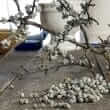Background
- Myrica is a genus of about 35-50 species of small trees and shrubs in the family Myricaceae, order Fagales, found throughout most of the world. Occasionally, the genus is divided into two genera, Myrica and Morella, with the former restricted to only a few species and the remainder appearing under Morella. Common names include bayberry, bay-rum tree, bog-myrtle, candleberry, sweet gale, and wax-myrtle.
- Several species of Myrica have been used in folk medicine in Asian, Native American, European, and African cultures. According to Daniel Moerman's Medicinal plants of Native America, the branches of sweet gale (Myrica gale) were used by the Bella Coola Indians of British Columbia to prepare decoctions for use as a diuretic or as a treatment for gonorrhea. Other Native American peoples have used bayberry for dysentery, diarrhea, fevers, gynecological conditions, bleeding in the uterus, and as a toothache remedy. Myrica cordifolia, native to South Africa, has been traditionally used as an astringent, food source, and for tanning hides. Another species indigneous to Africa, Myrica quercifolia, has also been prescribed by native herbalists to cure stomachaches.
- The early American colonists did not initially use the herb medicinally, but rather made candles, soaps and cosmetics from the bayberry fruit.
- Today, bayberry remains popular in Asian herbalist traditions. In Taiwan, bayberry is often recommended for stomach disorders and diarrhea, and in China, it is used as an astringent and pain reliever.
- Human data on the therapeutic use of bayberry for any condition are currently lacking. However, a number of early studies suggest that Myrica may have beneficial effects, including anticancer, antioxidant, blood pressure-lowering, antifungal, and antibacterial activities.
- Bayberry is not listed in the United States Food and Drug Administration (FDA) Generally Recognized as Safe (GRAS) list.
References
Natural Standard developed the above evidence-based information based on a thorough systematic review of the available scientific articles. For comprehensive information about alternative and complementary therapies on the professional level, go to . Selected references are listed below.
- Bao, J, Cai, Y, Sun, M, et al. Anthocyanins, flavonols, and free radical scavenging activity of Chinese bayberry (Myrica rubra) extracts and their color properties and stability. J Agric Food Chem 3-23-2005;53(6):2327-2332.
View Abstract - Chistokhodova, N, Nguyen, C, Calvino, T, et al. Antithrombin activity of medicinal plants from central Florida. J Ethnopharmacol 2002;81(2):277-280.
View Abstract - Fang, Z, Zhang, M, Tao, G, et al. Chemical composition of clarified bayberry (Myrica rubra Sieb. et Zucc.) juice sediment. J Agric Food Chem 10-4-2006;54(20):7710-7716.
View Abstract - Jacinto, CM, Nelson, RP, Bucholtz, GA, et al. Nasal and bronchial provocation challenges with bayberry (Myrica cerifera) pollen extract. J Allergy Clin Immunol 1992;90(3 Pt 1):312-318.
View Abstract - Kobayashi, K, Ihara, S, Kobata, A, et al. Inhibitory effect of Myrica bark on lipase activity in mouse plasma and gastrointestinal tract. J Med Food 2008;11(2):289-293.
View Abstract - Kuo, PL, Hsu, YL, Lin, TC, et al. Prodelphinidin B-2 3,3'-di-O-gallate from Myrica rubra inhibits proliferation of A549 carcinoma cells via blocking cell cycle progression and inducing apoptosis. Eur J Pharmacol 10-6-2004;501(1-3):41-48.
View Abstract - Liao, X, Lu, Z, Du, X, et al. Collagen fiber immobilized Myrica rubra tannin and its adsorption to UO2(2+). Environ Sci Technol 1-1-2004;38(1):324-328.
View Abstract - Matsuda, H, Yamazaki, M, Matsuo, K, et al. Anti-androgenic activity of Myricae Cortex--isolation of active constituents from bark of Myrica rubra. Biol Pharm Bull 2001;24(3):259-263.
View Abstract - Patel, KG, Bhalodia, PN, Patel, AD, et al. Evaluation of bronchodilator and anti-anaphylactic activity of Myrica sapida. Iran Biomed J 2008;12(3):191-196.
View Abstract - Patel, KG, Patel, KV, Shah, JH, et al. Evaluation of the effect of Myrica sapida on bronchoconstriction and bronchial hyperreactivity. Pharmazie 2008;63(4):312-316.
View Abstract - Popovici, J, Bertrand, C, Bagnarol, E, et al. Chemical composition of essential oil and headspace-solid microextracts from fruits of Myrica gale L. and antifungal activity. Nat Prod.Res 2008;22(12):1024-1032.
View Abstract - Prince, HE and Meyer, GH. Hay fever from Southern Wax-Myrtle (Myrica cerifera): a case report. Ann Allergy 1977;38(4):252-254.
View Abstract - Sylvestre, M, Legault, J, Dufour, D, et al. Chemical composition and anticancer activity of leaf essential oil of Myrica gale L. Phytomedicine 2005;12(4):299-304.
View Abstract - Tong, Y, Zhou, XM, Wang, SJ, et al. Analgesic activity of myricetin isolated from Myrica rubra Sieb. et Zucc. leaves. Arch Pharm Res 2009;32(4):527-533.
View Abstract - Wang, DY and Liu, EG. A new diaryheptanoid from the bark of Myrica rubra. Nat Prod Res 3-10-2008;22(4):292-295.
View Abstract







